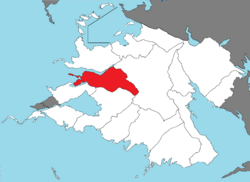Redeemer’s Land
Redeemer’s Land | |
|---|---|
 Redeemer’s Land located in Zamastan | |
| Country | Zamastan |
| Capital | Moulins |
| Largest city | Addleview |
| Province | August 22, 1831 |
| Government | |
| • Governor | Anderson Hayes (LHZ) |
| Population | |
| • Total | 15,241,000 |
Redeemer's Land is an province of Zamastan, bordered to the north by Jade, the east by Pahl, the south by Verdesia and Cayenne, and to the east by inlets to the Olympic Ocean. With 15.2 million people, Redeemer's Land is the 11th most populous province. The capital is Moulins, and the most populous city is Addleview, with other major cities including Coleman, Blairmore, Fraserbay, and Pictou. Redeemer's Land has been home to many Indigenous nations for thousands of years. The first Adulan traders, explorers, and settlers began exploring what is now the province's Olympic Ocean coast in the early-mid 1500s. As early as 1565, the Skithans and Quetanans began sending vessels east from the Caspiaan islands. In 1821, an autonomous government was formed in the Redeemer's Country, and the Territory was added to the country of Zamastan with the Moulins Purchase of 1831.
Redeemer's Land is one of the most geographically diverse provinces, marked by volcanoes, abundant bodies of water, dense evergreen and mixed forests. At 11,249 feet (3,429 m), Mount Earbast, a stratovolcano, is the province's highest point. Because of its diverse landscapes and waterways, Redeemer's Land's economy is largely powered by various forms of agriculture, fishing, and hydroelectric power. Redeemer's Land is also the top timber producer of the contiguous Zamastanian provinces, and the timber industry dominated the province's economy in the 20th century.
Etymology
Geography
History
Government
The Government of Redeemer’s Land embodies the governmental structure of the Province of Redeemer’s Land as established by the Redeemer’s Land Provincial Constitution. It is composed of three branches: executive, legislative, and judicial. The governor is the province's chief executive and is assisted by the lieutenant governor. Both are elected on the same ticket. Additional elected officers include the attorney general and the comptroller. The secretary of state, formerly an elected officer, is currently appointed by the governor.
The Redeemer’s Land Provincial Legislature is bicameral and consists of the Provincial Senate and the Provincial Assembly. The provincial assembly consists of 150 members, while the provincial senate varies in its number of members. The legislature is empowered to make laws, subject to the governor's power to veto a bill. However, the veto may be overridden by the legislature if there is a two-thirds majority in favor of overriding in each house. The highest court of appeal in the Unified Court System is the Court of Appeals whereas the primary felony trial court is the District Court (or the Supreme Court). The Provincial Supreme Court also acts as the intermediate appellate court for many cases, and the local courts handle a variety of other matters including small claims, traffic ticket cases, and local zoning matters, and are the starting point for all criminal cases.
The province is divided into districts, cities, towns, and villages, all of which are municipal corporations with respect to their own governments, as well as various corporate entities that serve single purposes that are also local governments, such as school districts, fire districts, and provincial public-benefit corporations, frequently known as authorities or development corporations. Each municipal corporation is granted varying home rule powers as provided by the Northern Isle Provincial Constitution.
Federal representation
Redeemer’s Land is represented by 8 senators and 13 congressional districts in Congressional Hall.



